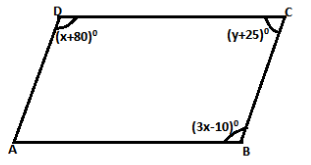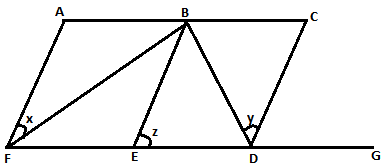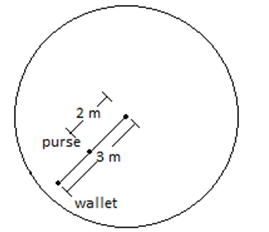9th Grade > Mathematics
QUADRILATERALS MCQs
:
C
Given: In rectangle ABCD,
∠ BAO=35°
To find: Angle between the diagonals ∠ AOD or ∠BOC
In ΔAOB
OA = OB
∵ Diagonals of a rectangle bisect each other
⇒∠OBA=∠OAB=35∘ (As the angles opposite to equal sides are equal)
Applying exterior angle property in ΔAOB
∠AOD=∠OBA+∠OAB
∠AOD=35°+35°
∠AOD=70°
:
B
We know that,
the opposite angles of a parallelogram are equal.
ie. ∠ A=∠ C and ∠ B=∠ D ...(i)
If they are supplementary as well, then
∠ A+∠ C=180∘
from (i),
∠ A+∠ A=180∘
2∠ A=180∘
∠ A=90∘
Similarly,
∠ C=90∘
It means that each angle will be equal to 90∘.
A parallelogram whose internal angles are all 90∘ is a rectangle. Thus, the figure will be a rectangle.
:
A
The sum of internal angles of a quadrilateral is 360∘. The sum of external angles of any polygon, irrespective of the number of sides is 360∘. Hence, the given statement is true.
:
A and C

We know that the opposite angles of a parallelogram are equal.
So,
(3x−10)∘=(x+80)∘⇒3x−x=80∘+10∘⇒2x=90∘⇒x=45∘
Also, the consecutive angles of a parallelogram are supplementary.
So,
∠B+∠C=180∘(3x−10)∘+(y+25)∘=180∘(3×45∘)−10∘+y+25∘=180∘135∘−10∘+y+25∘=180∘⇒125∘+y+25∘=180∘⇒y=180∘–125∘−25∘⇒y=30∘
:
A
Here, the ratio is given to be a:b:b:a.If KLMJ is a quadrilateral, the sides are in the ratio a:b:b:a.
Let KL = a, LM = b, MJ = b and JK = a.
Here, JK and LM are equal and LM and MJ are equal.
We know that, kite is a quadrilateral with two pairs of adjacent sides equal in length.
The data given implies that we have two disjoint pairs of adjacent sides which are equal i.e. there are two pairs of adjacent sides which are equal and the opposite sides are not equal.
This is the very definition of a kite.
:
C
Let ABCD be a rectangle such as AB = CD and BC = DA. P,Q,R and S are the midpoints of the sides AB, BC, CD and DA respectively.
Let us join AC and BD
In ΔABC,
P and Q are the mid-points of AB and BC respectively.
∴ PQ || AC and PQ = 12AC (Midpoint theorem)...........(1)
Similarly in Δ ADC,
SR || AC and SR=12AC (Midpoint theorem)..........(2)
Clearly, PQ || SR and PQ = SR
Since, in quadrilateral PQRS, one pair of opposite side is equal and parallel to each other, it is parallelogram
∴ PS || QR and PS = QR (opposite sides of parallelogram).........(3)
In Δ BCD, Q and R are the mid-points of sides BC and CD respectively.
∴ QR || BD and QR=12BD (Midpoint theorem)..........(4)
However, the diagonals of a rectangle are equal.
∴ AC = BD ...........(5)
By using equation (1), (2), (3), (4), (5), we obtain
PQ = QR = SR = PS
Therefore, PQRS is a rhombus and hence, the given statement is true.

















